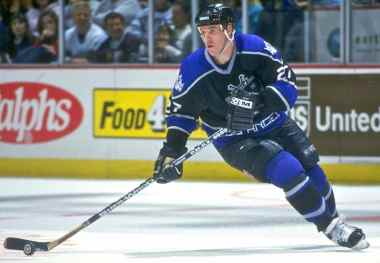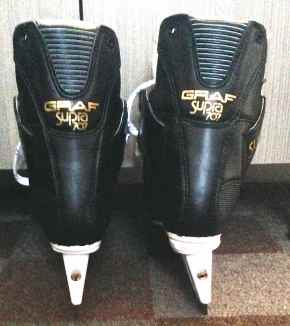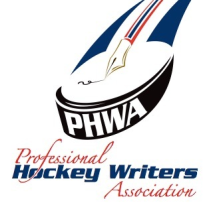
retired from the National Hockey League in 2008, due to injury.
But he made his triumphant return to the ice last summer, and
what it took to get him back on skates was a minor feat of
engineering, with some ingenuity and heart thrown in as well.
(click above to view larger image)
Photo courtesy Los Angeles Kings
By the same token, they also pay a high price due to injuries, and all too frequently, they are career-ending, and often debilitating after a player retires.
If you talk to NHL athletic trainers, they can all tell horror stories about how players often retire with fingers, toes and limbs that are bent in ways they aren’t meant to be, and that’s just the tip of the iceberg regarding the injuries and maladies hockey players often have to live with after retirement.
Looking at retired Los Angeles Kings players, center Gene Carr has considerable difficulty when he walks due to the heavy wear and tear of the game, forcing him to use a cane.
Concussions ended the careers of former right wing Dave Taylor, center/right wing Ian Laperriere, and right wing Adam Deadmarsh.
Right wing Jim Fox, now the team’s television color analyst, had his career ended by a knee injury that still affects him today.
Due to the rough, physical brand of hockey he played, retired right wing/defenseman Marty McSorley now lives with a debilitating hip condition.
Those are just a few examples. But another former Kings player who has been forced to deal with debilitating injuries after retirement is right wing Glen Murray, who played 16 seasons in the NHL, including eight seasons with the Boston Bruins (two stints), three with the Pittsburgh Penguins, and seven with the Kings.
In 1,009 NHL regular season games, Murray scored 337 goals and contributed 317 assists for 651 points, with 679 penalty minutes. In post-season play, he scored twenty goals and added 22 assists for 42 points, with 66 penalty minutes in 94 playoff games.
Note the angle of the skate blade.
(click above to view larger image)
Photo courtesy Glen Murray
Although he never won the Stanley Cup, Murray had a full NHL career, no doubt. Nevertheless, he was forced to retire after the 2007-08 season, when he was with the Bruins, due to the cumulative effects of right ankle and foot injuries.
“I’ve basically got a club foot,” Murray explained. “My right foot is deformed—that’s the best way I can say it. I had a few too many surgeries on it. The last one was minor surgery which turned into me not being able to play after it.”
Today, Murray serves as a Development Consultant for the Kings, working with their young prospects while they hone their skills in the minor leagues, including a once-a-month trip back east to work with prospects playing for the team’s primary minor league affiliate, the Manchester Monarchs of the American Hockey League.
The big problem for Murray was that his ability to teach was constrained by his inability to skate—he was stuck on the sidelines because he couldn’t even get his right foot into a skate boot without pain.
To make matters worse, not only was Murray’s ten-year-old son, Parker, too young to have ever seen his father play the game, they couldn’t even skate together, now that Parker is playing hockey.
But all that changed last summer when a custom-designed skate—a minor engineering feat—got Murray back on the ice.
“He’s got that problem with his ankle, and it’s never going to heal,” Kings President/General Manager Dean Lombardi said. “They designed a special skate for him. [Kings head equipment manager] Darren Granger did it. It’s actually genius, because the reality is that the bone is deformed. But the way they designed the skate is incredible.”
“That was awesome,” Lombardi added. “He’s been through a hard time, but he feels like a little kid again. The trainers made him a special skate, and that was a big day for him. I don’t think people realize—a guy has skated [for] his whole life, and then, couldn’t skate. But when he put on that skate and went out there, it was great. Everybody was pretty pumped for him.”
“We were just trying to get him back on the ice,” said Kings head athletic trainer Chris Kingsley. “It was a shame seeing him unable to skate, which was what he did during his career, and most of his life. So we said, ‘how can we get him [back to skating]?’”
It all started prior to the Kings’ annual Development Camp in July 2013.
“We sent him to GRAF, a skate company, to get a skate made, and they made it as big as they could, to fit his foot,” said Granger. “If you’ve seen him walk, he’s got some ankle issues. His foot is turned over, to the outside. He kind of walks on the outside edge of his foot, which, obviously, is not conducive to skating.”
“They couldn’t really design it as specific as Darren Granger did,” Murray said of GRAF. “They tinkered with it. They made me a bigger skate that’s softer inside so I could deal with the pressure—when you tie your skates, you tie them tight. They designed a skate that would be more comfortable to, at least, get on the ice, and explain different things that we’re trying to do [when he skates with Kings prospects], instead of being on the sidelines.”
GRAF did their best, but what they came up with was still not enough to get Murray back on the ice.
(click above to view larger image)
Photo courtesy Glen Murray
“All the trainers [and equipment staff] had a part,” added Murray. “Darren Granger, [assistant equipment manager] Dana Bryson, Kingsley, [assistant equipment manager] Denver Wilson. They were all trying to figure out a way that I could get on the ice and help [Kings’ prospects], instead of being stuck on the sideline.”
Granger indicated that they were determined to get Murray back on the ice, even though his skating would be quite limited.
“What we wanted to do was to get him on the ice,” said Granger. “Being able to skate with his kids was what started it, and then he was able to get out there for Development Camp, which was great.”
“My son is the same age as Glen’s son, so I see him all the time,” added Granger. “It was killing me that he couldn’t be out there skating with him, so we just started at trying to figure something out to get him out there.”
Granger then explained the engineering behind the skate.
“What we had to do was put a huge wedge between the sole of his skate and the blade, [tilting the blade outward],” he explained. “That allowed him to be able to walk in his skates more flat-footed than he was before (see photo).”
“What happened then was because we wedged the blade—the skate blade was way off, obviously—it allowed him to walk in a fairly straight line, but the blade was on an angle—the whole edge of the blade,” he elaborated.
But as they made modifications, they would find another problem to address.
“It took two to three days, with me going on the ice—Development Camp hadn’t started—testing it, then they tinkered with it more,” said Murray. “So it was two to three days that they would sleep on it, and think about something else to add to it.”
“It was trial and error,” Kingsley noted. “We’d have him try it on, then, we’d go from what he said in his feedback. We eventually got him as comfortable as we could.”
“He went on the ice seven times before we got it right,” said Granger. “He’d put it on, skate, and come off. We tried to give him something that had a big, wide base on it, like a goalie skate. We basically cut the ankle portion of the boot out, so there was nothing there at all.”
A bit more engineering was required for them to get it right.
“We sent him on the ice to skate, but the skate would just turn because it was on such an angle,” said Granger. “Then we decided we’d build up the inside edge of the steel to counteract how the blade was sitting. We sharpened it higher than the outside edge so that the blade would go straight.”
“It took everybody thinking it out—why, when we adjusted the blade, was he not able to go straight? The blade kept turning to the outside without him doing it,” added Granger. “At least we got him going in the right direction.”
Once they fixed that, there was an unexpected side effect.
“Because the skate was making his knee go into a position that was uncomfortable, they fitted him with a brace to stabilize his knee in a position that didn’t hurt, because his ankle was now in a position that was more straight than he’s used to when he’s walking,” Granger noted.
Kingsley’s expertise proved to be invaluable here.
“The angle of the blade puts tension on his knee, so we hooked him up with a knee brace to alleviate that,” he explained. “I was just trying to help alleviate pressures on the ankle, or even his knee. I just added my insight on how I thought it should go.”
Kingsley indicated that it was all about comfort.
“It really evolved that way—just making him comfortable,” said Kingsley. “Talking with Darren Granger, and how we could get him into a skate, making him the most comfortable, and as functional as he can be.”
“He had ankle surgery at the end of his career, and he had a problem where he couldn’t put on a skate because of the pain,” added Kingsley. “It’s all about comfort. We know it’s not going to be about starts and stops. It’s about being able to push around, and stand up there for a practice with his kids. I think that’s important.”
“It’s nice that he can get out there and skate,” said Granger. “That was the whole idea, not that he would be playing in an alumni game, or something, but he would able to get out there and move around. I think, if you ask him, he’d probably say it’s a little bit sore. But at least he’s able to do something. That was the plan all along, and what was important.”
The first big test for Murray and the skate was the Kings’ annual Development Camp last July. Both passed with flying colors.
“This past summer was the first time I was on the ice with them,” he said. “We tinkered with [the skate] in June, and Development Camp was in July.”
As reported earlier, Murray is now able to get onto the ice with Kings prospects whenever he is in Manchester.
“I’m not going to outskate anyone, that’s for sure, not that I did before,” he noted. “I can move a little bit, but not that much. When I go to Manchester—I go there once a month—I can go on the ice with our development crew there, which is great. I love it. It’s a great to be out there with the guys and explain certain things we’re trying to make them better.”
Perhaps more important, Murray is now able to share the ice with his son.
“If you ask anyone who’s played, to get out there with your son, it’s a great relationship to have,” he beamed. “I skate with my son’s team, which is great. I hadn’t been [on the ice] with them until this year. It’s great to be out there to do drills with the kids, help them out, and help them learn the game the right way.”
That was what it was all about for those who engineered the skate.
“As an NHL player, when you retire, that’s what you want to do, right, if you have kids? It’s a huge thing,” said Granger.
“His son never got to see him play in the NHL,” said Kingsley. “At least now, he can be out there to coach him, push pucks around, and be there with the kids.”
“It was awesome,” added Kingsley. “You could see the smile on his face, and he was out there, during Development Camp—he was pretty happy. It was awesome to have him out there instead of just on the sidelines, because he is part of the development team. The guy played a lot of years in the NHL.”
“It was good for us to see him out there—a happy moment.”
Murray will be forever grateful.
“I thank them every day for helping me out, and getting me back on the ice,” he said. “They just laugh and say, ‘no problem.’ That’s how they are.”
“These guys shouldn’t have been trainers. They should have been inventors or people who build things.”
 Frozen Royalty by Gann Matsuda is licensed under a Creative Commons Attribution-NonCommercial-NoDerivs 3.0 Unported License. You may copy, distribute and/or transmit any story or audio content published on this site under the terms of this license, but only if proper attribution is indicated. The full name of the author and a link back to the original article on this site are required. Photographs, graphic images, and other content not specified are subject to additional restrictions. Additional information is available at: Frozen Royalty – Licensing and Copyright Information.
Frozen Royalty by Gann Matsuda is licensed under a Creative Commons Attribution-NonCommercial-NoDerivs 3.0 Unported License. You may copy, distribute and/or transmit any story or audio content published on this site under the terms of this license, but only if proper attribution is indicated. The full name of the author and a link back to the original article on this site are required. Photographs, graphic images, and other content not specified are subject to additional restrictions. Additional information is available at: Frozen Royalty – Licensing and Copyright Information.



Once again Gann You stole the show with a GREAT article! Congrats to Murray and Kudos to the Kings staff. It’s also great to see the Kings orginization keeping so many great ex-Kings involved in the Kings family business